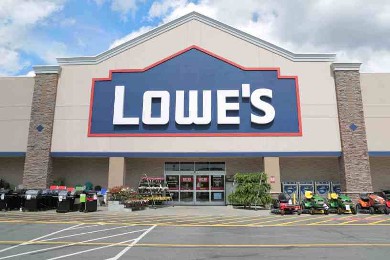WILL MORE RETAILERS FOLLOW LOWE'S AND HOME DEPOT IN PHASING OUT CARPETS & RUGS MADE WITH PFAS?

Lowe's has announced it will stop purchasing carpets and rugs containing PFAS in the U.S. and Canada, after beginning the transition a year ago. |
Lowe's, the nation's second-largest home improvement retail chain, has joined with the largest -The Home Depot - in announcing it will stop purchasing all carpet and rugs containing PFAS in the U.S. and Canada.
The Home Depot announced last month that it would no longer sell carpets with PFAS by the end of the year. In both instances, the announcement was made by an environmental group, NRDC.
Per- and polyfluoroalkyl substances (PFAS) are a group of man-made chemicals that have been manufactured and used in a variety of industries around the globe, including in the United States since the 1940s. There is evidence that exposure to PFAS can lead to adverse human health effects.
When reached for comment Lowe's spokeswoman Sarah Lively said the retailer started the transition a year ago but would not elaborate further.
Home Depot will stop selling carpets with PFAS by the end of 2019 as part of a strategy launched in 2017.
The Home Depot said the move is in keeping with its chemical reduction strategy that it launched in 2017. "Excluding PFAS from the carpets and rugs we sell is another example of our shared commitment to building a better future for our customers and the planet," Ron Jarvis, vice president of environmental innovation at The Home Depot, said in a statement.
According to the Carpet and Rug Institute (CRI), the industry trade group representing 90% of U.S. carpet manufacturers, most residential and commercial carpets are treated with PFAS-based stain- and soil-repellents.
CRI said that PFAS-containing treatments can be applied to carpets/rugs at four different stages: (1) during the manufacturing of the carpet fibers; (2) during the carpet and rug manufacturing process, at the carpet and rug mill; (3) after the carpet and rug manufacturing process, at a separate finishing facility or in stores at the time of sale; or (4) post-sale of the carpet or rug by consumers or professional cleaners.
An Ecology Center report released in 2018 found PFAS in half of all carpet samples tested (6 out of 12).
To date, the Environmental Protection Agency (EPA) has not issued regulations on PFAS. It has begun the process of listing PFOA and PFOS -- two kinds of PFAS -- as hazardous substances under the Superfund law, and vows to help communities deal with existing contamination and identify solutions to address PFAS in the environment.
Manny Vickers and one of his chemists at the Fiber-Shield Industries Inc.'s laboratory in Yapank, New York. The company's carpet and rug protection products are PFAS-free.
Last year, for example, California proposed that carpets and rugs containing PFAS should be considered a priority product under the state's Safer Consumer Products program. This could lead to the development of safer alternatives to the use of these chemicals in carpets and rugs. The California Department of Toxic Substances Control has identified carpets and rugs as the largest potential sources of significant and widespread PFAS exposures, especially for children.
"Unless retailers can be assured that their vendors can offer alternative technologies for carpet and rug protection, I believe that in a very short time they are going to be following the lead that Home Depot and Lowe's have set," said Manny Vickers, president and COO of Fiber-Shield Industries, Inc.,
a maker of applied carpet and rug protection products.
Vickers sees changes in regulations on the horizon, possibly within the next year or two. "It could cost manufacturers and distributors a lot of business if they are not proactive. What's more, I think that those who have PFAS in their products may face additional regulations for carpets and rugs already in the landfills."
Indeed, Fiber-Shield started testing its applied carpet and rug protection products for PFAS in 2003. "At that that time, the independent labs could only test in parts per million and all Fiber-Shield products tested PFOA-, PFOS-, PFAS- free. In 2019 the testing was able to detect parts per billion. I'm happy to report that our products tested PFOA-, PFOS-, PFAS-free -- including our new super spot remover for water cleanable carpets, Fast-Kleen."